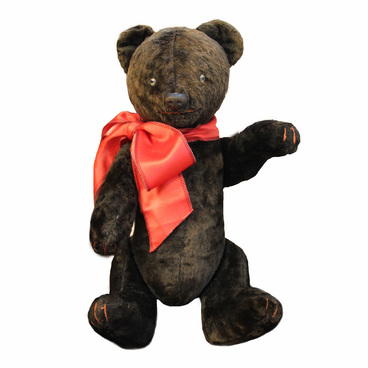The museum doll nowadays is a rare copy of toys produced by Szrajer & Fingerhut Company. The doll appeared in Kalish, a small town in Poland. At different times of the 19th century, this town was the territory of the Kingdom of Poland and the Russian Empire. Therefore, this toy has a Polish-Russian origin and is not that common in other countries.
Doll
Creation period
1890s
Dimensions
74x14x12 cm
74х14х12 см
74х14х12 см
Technique
Porcelain, paper mache
Exhibition
1
Open in app#1
Doll
#8
#9
The factory where this doll was manufactured was launched in the late 19th century. In the 1870s its founder Jacob Fingerhut was a manager at a puppet factory where he met Adam Szrajer, his future companion. They established Szrajer & Fingerhut factory in 1884. At that time, the first three floors of the factory were equipped for painting, packaging, machinery, lather, milling and printing workshops and a small space was organized for manufacturing of plush toys and dolls.
#10
Dolls at the Szrajer & Fingerhut factory were made of special biscuit porcelain. Those toys had glass blinking eyes with eyelashes, their bodies were made of wood and paper-mache. Real human hair or mohair - goat wool – were used for hairstyling, and hired masters sewed outfits for them. Later, the company expanded the list of raw materials and began to use celluloid. The dolls were packed in thin cigarette paper and delivered to the living premises.
#11
In the 1930s Shirlikes dolls gained their popularity - they looked like Shirley Temple, an American child actress. Adam Szrajer welcomed the idea and the Kalish factory made its own version of the dolls, which the company put on sale in other countries, including the USA.
#12
Szrajer & Fingerhut enhanced its products line. The factory manufactured blinking dolls, assembling houses, toy furniture, wood cut animals, airplanes and educational toys for children. The firm was famous for its quality and integrity. Factory accepted orders for its goods from Palestine, Latin America and European countries. For its toys, the company was awarded a prize at the World Exhibition in New York in 1939. The firm folded up with the beginning of the Great Patriotic War.
#13
The museum doll was manufactured around the 1890s. Its body is made of paper-mache, it has movable ball-jointed hands and legs. She got into the museum in a bad condition: part of its face was broken, the original suit was lost, natural hair was also badly damaged. The face of the doll was restored at the Samara Regional Art Museum. The wig was restored and a new outfit for the doll was sewn by Olga Bakanova – an artist of the Children 's Art Gallery and the author of the project Exclusive Doll from the Clodt’s Mansion.
#14
Mark “449, 15, Ф” is embossed on the back of the doll’s head.
Exactly this mark helped identify the factory where the doll was made.
read morehide
00:00
00:00
1x
Doll
Creation period
1890s
Dimensions
74x14x12 cm
74х14х12 см
74х14х12 см
Technique
Porcelain, paper mache
Exhibition
1
Open in app
Share



